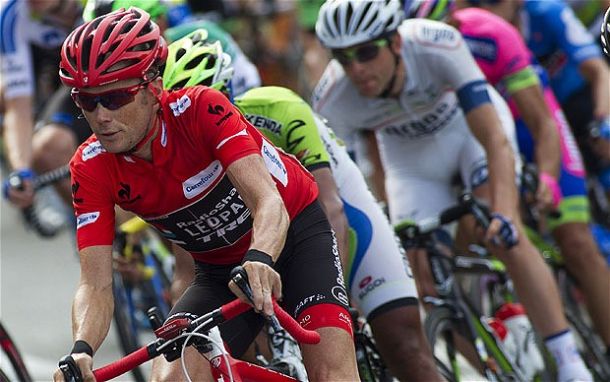Stage Eight: Baeza - Albacete 207km
A flat stage running through open lands between Baeza and Albacete. There is little remarkable about the parcours, but the open terrain lends itself to winds which could make for a surprisingly lively stage. However in all likelihood it will end in a large bunch sprint where sprinters such as Nacer Bouhanni (FDJ), John Degenkolb (Giant-Shimano), Peter Sagan (Cannondale), Michael Matthews (Orica GreenEGDE) et al should battle for victory. There is a technical right hand turn at a roundabout inside the final kilometre, followed by a straight 600-700m run to the line, the finish will be very fast. With so few clear cut bunch sprints in the race, this stage will be targeted by all the sprinters and the favourites may be trumped by an ambitious rider. Andrea Guardini (Astana), Jens Debusschere (Lotto Belisol), Moreno Hofland (Belkin) and Matteo Pelucchi (IAM Cycling) all come into the race with stage winning form and will bear watching.
Stage Nine: Carboneras de Guadazaón - Aramón Valdelinares 185km
The second significant uphill finish of the race, but where the difficulty at the finish of stage six comes from a steep gradient, this finish is less steep but features much more concentrated climbing inside the final 25km. It begins with the Alto de San Rafael, an 11.5km climb at an average of 4.3%, after which there is a short descent before the more challenging climb to the finish atop the Aramón Valdelinares. Aramón Valdelinares is 8km long with an average of 6.6%, and with much of the final 3km at around 8.5%, before a shallower run to the line. The shallow run to the line suits a climber with a good sprint finish, such as Alejandro Valverde (Movistar).
Stage Ten: Real Monasterio de Santa María de Veruela - Borja 36.9km ITT
The first of two individual time trials in the race, this one is the longest at 36.9km, and also the hilliest which offers a little solace to the climber. The parcours effectively climbs for the opening 11.2km, before a long slow descent to the finish at Borja. The gradient of the climb isn't overly testing so the stage should still suit a powerful time trial specialist well enough. Tony Martin (Omega Pharma-Quick Step) is the best time trialist in the world and should be the favourite, Fabian Cancellara (Trek Factory Racing) beat him on a similar looking time trial in last year's race, but the climb was more difficult which suited the Swiss rider. Amongst the GC contenders Chris Froome (Team Sky) will be the clear favourite to excel on this stage and gain time on his rivals, so much so that he is likely to push hard for the stage honours as well.
Stage Eleven: Pamplona - Santuario de San Miguel de Aralar 153.4km
The GC battle is about to become serious with a nasty final climb to the Santuario de San Miguel de Aralar. The majority of the stage is unremarkable, there are small hills early on but the first real action should come on the climb to Puerto de Lizarraga, which is long and should sap the legs of the peloton prior to the day's main event, the climb to the finish atop the Alto de San Miguel de Aralar. At 9.9km long, an average gradient of 7.5% and ramps of up to 14%, this should force the GC contenders to seize control of the race. The difficult 14% section of the climb begins around 2.5km from the finish, which is where the action should be hottest.
Stage Twelve: Logroño - Logroño 166.4km
Stage twelve features eight laps around Logroño. As with all urban circuits there are a few technical corners to navigate, but the peloton will have plenty of opportunity to become familiar with the course ahead of the high speed final lap, which should end in a bunch sprint.
Stage Thirteen: Belorado - Obregón. Parque de Cabárceno 188.7km
Another stage that is well suited to the ambitious breakaway riders; either from the early escape group, or from an aggressive attack on the climbs in the second half of the race. The climbs of the Alto Estacas de Trueba, Puerto de la Braguía and Alto del Caracol become progressively more difficult, with the final one at 10.5km and 5.5%, and should reduce the size of the group that reaches the finish. A steep ramp with 2.5km remaining will further break things up, and could even prompt a strong attack from a GC rider, though they may wish to save their energy for the following stage, leaving the way open for an opportunist such as Philippe Gilbert (BMC Racing Team) or Cancellara.
Stage Fourteen: Santander - La Camperona. Valle de Sabero 200.8km
Stage Fourteen presents the peloton with the most difficult challenge of the race so far, with three significant climbs to overcome. First up is the Collada de la Hoz, a 7.5km climb at an average of 5.8%, which serves as an appetiser for the more difficult climbs ahead. Next up is the huge climb of Puerto de San Glorio, which is long at 20.9km, with an average gradient of 5.8%; it ramps throughout and is steepest early on. After the descent the peloton has around 50km of slightly downhill terrain to cover before the greatest challenge of the day, La Camperona. At 8.3km long and with an average gradient of 7.5%, La Camperona sounds difficult but manageable, however the bare figures are misleading. As the profile below shows, all the difficulty is compressed into the final 2.3km of the climb, where the average gradient exceeds 14% and reaches 19.5% at its steepest. This is a climb for the pure climbers and a perfect opportunity for Nairo Quintana (Movistar) and Joaquim Rodriguez (Katusha Team) to take the race to their rivals.
All stage profiles taken from http://www.lavuelta.com





































